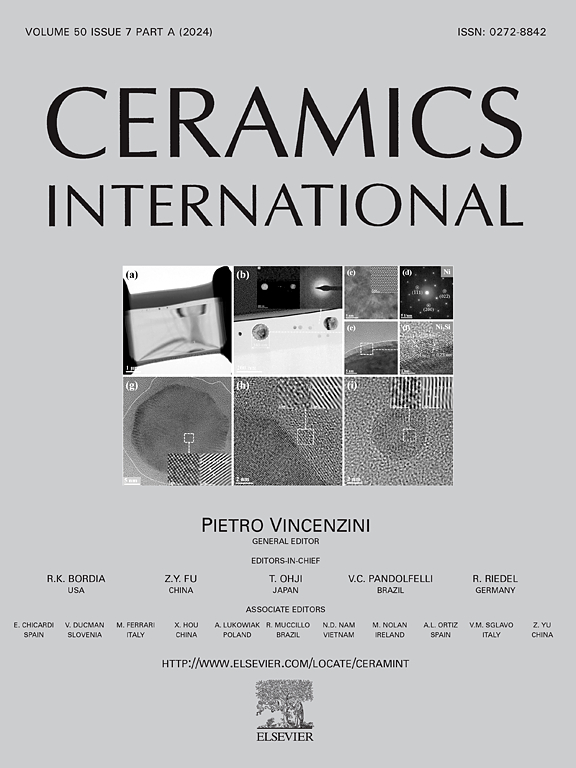Microstructural evolution and performance factors of Si-O-N ceramics with dielectric and mechanical properties
IF 5.1
2区 材料科学
Q1 MATERIALS SCIENCE, CERAMICS
引用次数: 0
Abstract
The Si-O-N system ceramics, which include silicon nitride (Si3N4), silica, and silicon oxynitride (Si2N2O), not only enhance thermal stability and wave-transparent performance simultaneously but also exhibit excellent designability in terms of composition and microstructure. They hold significant potential to replace conventional wave-transparent materials, such as Si3N4. Herein, we investigated the preparation of Si-O-N system ceramics using gas pressure sintering method with silicon nitride and silicon dioxide as raw materials. The main focus is on the effects of sintering temperature and holding time on the microstructure, mechanical properties, and dielectric properties (both at room temperature and high temperature) of Si-O-N system ceramics. It was found that at a sintering temperature of 1700 °C, the Si-O-N ceramics predominantly exhibited the Si2N2O phase. However, with increasing sintering time, the Si2N2O transformed into Si3N4. The mechanical properties of the Si-O-N ceramics sintered at 1700 °C for 3 h showed that the density, porosity, flexural strength, and fracture toughness were 2.54 ± 0.01 g·cm−3, 4.32 %, 278 ± 17 MPa, and 7.45 MPa·m1/2, respectively. Their wave-transparent performance is exceptional, characterized by a dielectric constant with a real part of 5.27 and an imaginary part of 0.02 at 10 GHz, along with a remarkably low dielectric loss of 0.0038 at the same frequency.
具有介电性能和力学性能的Si-O-N陶瓷的微观组织演变及性能因素
由氮化硅(Si3N4)、二氧化硅和氮化氧硅(Si2N2O)组成的Si-O-N体系陶瓷不仅提高了热稳定性和波透明性能,而且在成分和微观结构方面具有优异的可设计性。它们有很大的潜力取代传统的波透明材料,比如氮化硅。本文研究了以氮化硅和二氧化硅为原料,采用气压烧结法制备Si-O-N体系陶瓷。主要研究了烧结温度和保温时间对Si-O-N体系陶瓷的微观结构、力学性能和介电性能(室温和高温)的影响。结果表明,在1700℃的烧结温度下,Si-O-N陶瓷主要表现为Si2N2O相。随着烧结时间的延长,Si2N2O转变为Si3N4。Si-O-N陶瓷在1700℃下烧结3 h的力学性能表明,Si-O-N陶瓷的密度为2.54±0.01 g·cm−3,孔隙率为4.32%,抗弯强度为278±17 MPa,断裂韧性为7.45 MPa·m1/2。它们的波透明性能优异,在10 GHz时的介电常数实部为5.27,虚部为0.02,同时在相同频率下的介电损耗非常低,为0.0038。
本文章由计算机程序翻译,如有差异,请以英文原文为准。
求助全文
约1分钟内获得全文
求助全文
来源期刊

Ceramics International
工程技术-材料科学:硅酸盐
CiteScore
9.40
自引率
15.40%
发文量
4558
审稿时长
25 days
期刊介绍:
Ceramics International covers the science of advanced ceramic materials. The journal encourages contributions that demonstrate how an understanding of the basic chemical and physical phenomena may direct materials design and stimulate ideas for new or improved processing techniques, in order to obtain materials with desired structural features and properties.
Ceramics International covers oxide and non-oxide ceramics, functional glasses, glass ceramics, amorphous inorganic non-metallic materials (and their combinations with metal and organic materials), in the form of particulates, dense or porous bodies, thin/thick films and laminated, graded and composite structures. Process related topics such as ceramic-ceramic joints or joining ceramics with dissimilar materials, as well as surface finishing and conditioning are also covered. Besides traditional processing techniques, manufacturing routes of interest include innovative procedures benefiting from externally applied stresses, electromagnetic fields and energetic beams, as well as top-down and self-assembly nanotechnology approaches. In addition, the journal welcomes submissions on bio-inspired and bio-enabled materials designs, experimentally validated multi scale modelling and simulation for materials design, and the use of the most advanced chemical and physical characterization techniques of structure, properties and behaviour.
Technologically relevant low-dimensional systems are a particular focus of Ceramics International. These include 0, 1 and 2-D nanomaterials (also covering CNTs, graphene and related materials, and diamond-like carbons), their nanocomposites, as well as nano-hybrids and hierarchical multifunctional nanostructures that might integrate molecular, biological and electronic components.
 求助内容:
求助内容: 应助结果提醒方式:
应助结果提醒方式:


